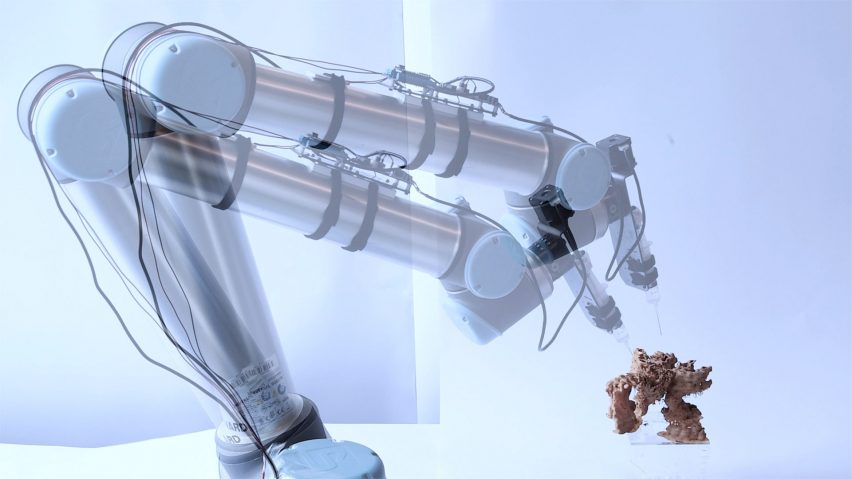California-based BioLab Studio has developed a system that uses 3D printers to construct wooden scaffolding that cultivates mycelium maintained by a robotic arm.
Bio Scaffold was developed by BioLab Studio founder Natalie Alima as a way of facilitating the growth of mycelium using 3D-printed wood-fibre sculptures.
"I was interested in architecture that biodegrades back to the earth and is intended to be eaten," said Alima.
"I'm always thinking about like the afterlife of products rather than designing just prior to thinking about how it's actually returning back to the earth."
The system involves a 3D program that builds optimised scaffolding out of a mixture that is fortified with hemp fibres and coffee grounds.
The wood composite acts as both a scaffold for the mycelium spores as well as a nutrient source. Calculations are done to establish a pattern of recesses on the scaffolds that facilitate or hinder the growth of the spores based on structural needs.
Alima designed a robotic arm that has a moisture sensor that interfaces with the form of the 3D-printed object in order to implant and moisturise the mycelium.
A language between physical and virtual
"So not only is the machine tending to the organism, but also the organism is influencing the machine's movement," said Alima.
"[It's] almost like a language between the two mediums, between the physical and the virtual realms."
The project began with the creation of small sculptures meant as household objects to test the program.
Now, Alima and collaborators Roland Snooks and Hesam Mohammedd are working to scale-up the technology to create insulation systems to be used in larger projects. For the smaller sculptures, the mycelium is meant to dot out the whole of the form, while for the larger, it will be integrated into the prospective building.
"For the second more architectural applications, the mycelium was intended to act as an intuitive material and provide a structural component for the wall power system," said Alima of the larger scale project, prospectively called Composite BioForms.
Because of the synthetic and non-biodegradable makeup of many insulation systems, Alima believes that her technique could provide a more sustainable alternative.
"See this architectural piece and watch it grow"
The system entails the enclosing of a wooden graft that has been implanted with the spores between two panels. The mycelium then grows, adding to the structure as an insulation material that can then be eaten.
Alima said that the ideal application for the project would be for temporary structures such as pavilions and that the lack of excess materials needed in the 3D printing process adds to the efficiency of the building process.
She also said that there is potential for a more performance-oriented use, where spectators could "see this architectural piece and watch it grow".
After growing for a set amount of time, the mycelium bursts through the wooden encasement and can be seen.
"I really tried to as an artist to embrace nature and show it off and kind of show that point that we're working with nature," she said.
"We're not concealing it, we're embracing its features and aesthetics."
Alima was born in Australia and holds a PhD from RMIT University in Melbourne, and her work includes experimentation with textiles and other accessory materials.
Other recent projects that include mycelium include a spore cannon meant to project it onto areas affected by wildfire in order to regenerate the soil and Studio MOM's bicycle helmet created from mycelium and hemp fibres.

